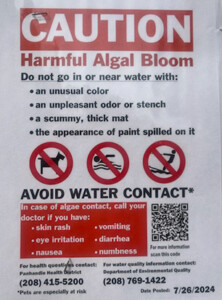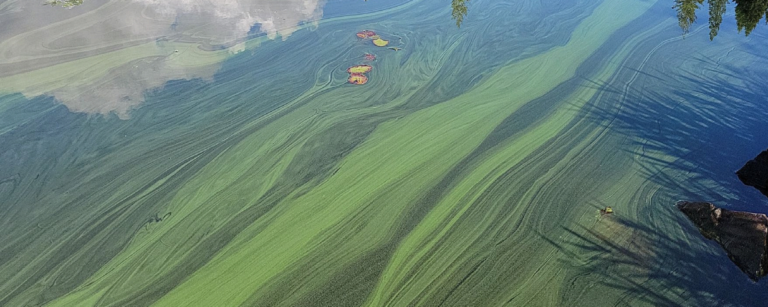Public Health Advisory Issued

Late Friday afternoon, a concerned resident of the north end of Hayden Lake notified DEQ of suspicious-looking water along the shoreline of Sportsmans peninsula. DEQ quickly confirmed the presence of a Harmful Algal Bloom and cautiously identified the extent of the affected area from the northernmost shores down to McLean’s Bay. Panhandle Health District followed up, issuing a public health advisory for the North Arm
This announcement comes as no surprise. July’s daily high temperatures have remained at or above 90 degrees for 19 out of 20 days across the middle of the month. The skies have been free of precipitation for much longer. The water of the north arm sustains a nutrient and oxygen balance that favors Cyanobacteria. Hot, dry, plus nutrient-rich – that’s the perfect equation for a bloom.
What does this mean for you?
Remember that in a bloom situation, the cyanobacteria population is dense enough to produce harmful toxins. These toxins can impact all animals, ranging from itchy toddlers to deathly ill pets.
- Caution—if you draw drinking water from the lake, boiling or filtering the water does not remove the toxins. Develop a backup strategy for providing clean drinking water and notify renters and visitors.
- If you have come in contact with HAB-containing water through swimming, bathing, or showering, PHD recommends washing off with fresh water.
- Fish harvested from the lake should have their fat, skin, and organs removed before cooking because toxins are more likely to collect in the fatty tissues.
- Cyanobacteria blooms can spread and move with the current, wind, and water traffic. Therefore, stay vigilant even outside of the designated affected area.
- Take caution anywhere the water appears discolored or murky, contains streaks or globs of scum or leaves green paint-like mats along the shoreline.
When will it end?
Toxin production will stop when the environmental conditions no longer support the cyanobacteria life cycle.
Technically, PHD will lift a health advisory when cyanotoxin levels are measured below the threshold for two weeks in a row. DEQ checks approximately every two weeks, so the soonest possible end to the current health advisory is mid-August.
Realistically, the cyanobacteria will stop reproducing at bloom levels when the water temperature cools, when rain introduces nitrogen and oxygen into the water, or when the hours of sunlight dwindle. Historically, Hayden Lake’s HABs have lasted from 2 to 17 weeks.
Ultimately, it is impossible to accurately predict when the HAB will cease. We know it’s here today, and if looking at a cloudless, sunny sky on a 90+ degree afternoon, it will likely be here tomorrow. Stay patient and ere on the side of caution.
If you suspect Cyanobacteria anywhere in public water:
DEQ HARMFUL ALGAL BLOOM HOTLINE (866) 671-5385
___________________
DEQ HARMFUL ALGAL BLOOM
EMAIL ALGAE@DEQ.IDAHO.GOV
___________________
DEQ HARMFUL ALGAL BLOOM ONLINE FORM https://www.deq.idaho.gov/report-a-potential-cyanobacteria-algal-bloom/
___________________




2 Responses
Would limiting boat traffic in that area be possible or helpful? Are there any signs at the boat launches? We’ve been here since 1969. It’s so sad to see the decline of Hayden’s water quality. I have been on committees to stop various developments from happening and wake enforcement. I guess I need to do more.
The variables that contribute to cyanobacteria growth include water temperature (warm), nutrient density and balance (lots of nutrients and a P:N ratio tipped toward P), oxygen concentration (low), and light energy (high). All of these factors shift toward sustaining the harmful algal bloom as the heat of summer persists and the water level slowly decreases. So, to get rid of or reduce the HAB, we need to cool the water, use up the phosphorus, raise the oxygen in the water, and reduce light penetration.
Boat traffic doesn’t move any of those needles in a direction that would make the HAB worse. In fact, some are inclined to argue that boat traffic does the opposite. It stirs the water, adding oxygen and raising turbidity, which in turn reduces light penetration, both of which would be hard on the cyanobacteria. But, boat traffic also stirs up nutrient-laden sediment. Conclusion: limiting boat traffic isn’t likely to either help or hinder the HAB growth.
Comments are closed.